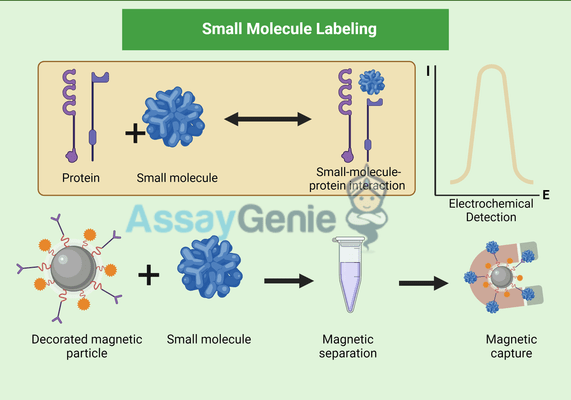Labeling Non-Antibody Proteins and Small Molecules: An Advanced Guide
In the evolving landscape of biochemical research and diagnostic assay development, the ability to label non-antibody proteins and small molecules with high precision has become indispensable. This advanced guide delves into the methodologies, challenges, and applications of labeling these crucial biomolecules, providing insights for researchers and developers aiming to enhance the specificity and sensitivity of their assays.
Understanding the Basics of Biomolecule Labeling
Biomolecule labeling encompasses a set of techniques used to attach detectable tags or labels to proteins, peptides, and small molecules. These tags can be fluorescent dyes, biotin, radioactive isotopes, or enzymes, facilitating the detection, tracking, and quantification of the labeled entities in complex biological matrices.
Techniques for Labeling Non-Antibody Proteins
Non-antibody protein labeling involves several methods, each with its unique advantages and limitations. Common techniques include:
- Site-Specific Labeling: Utilizes enzymes or chemical reactions that target specific amino acid residues, ensuring that the label does not impede the protein's function.
- Random Labeling: Involves chemical reactions with accessible functional groups on the protein, typically faster but may affect protein activity if critical residues are modified.
Strategies for Small Molecule Labeling
Labeling small molecules, given their diverse structures and functionalities, requires careful consideration of the labeling strategy to maintain the molecule's biological activity. Key approaches include:
Figure: Strategies for Small Molecule Labeling
Advanced Labeling Technologies and Their Applications:
Recent advancements have introduced more sophisticated labeling technologies, offering enhanced specificity and minimal impact on the biomolecule's function.
- Click Chemistry: A bioorthogonal approach that allows for the efficient and specific labeling of molecules in living cells and organisms.
- HaloTag Technology: A versatile method where a synthetic ligand covalently binds to a genetically encoded protein tag, facilitating the attachment of various labels.
These technologies find applications in a broad range of areas, from drug discovery and cellular imaging to the development of diagnostic assays and therapeutic monitoring.
Overcoming Challenges in Biomolecule Labeling:
Despite technological advancements, labeling non-antibody proteins and small molecules presents several challenges:
- Preservation of Biological Activity: Ensuring that the labeling process does not significantly alter the molecule's structure or function.
- Optimization of Label-to-Protein Ratio: Balancing the degree of labeling to achieve optimal signal without compromising the biomolecule's activity.
- Specificity in Complex Biological Matrices: Achieving high specificity and low background in the presence of diverse biomolecules.
Future Directions and Innovations:
Conclusion
References
- Kaur, J., Saxena, M., & Rishi, N. (2021). An overview of recent advances in biomedical applications of click chemistry. Bioconjugate chemistry, 32(8), 1455-1471.
- Lee, H., & Kim, E. (2018). HaloTag Technology: A Platform for Biomedical Applications. Biochemical and Biophysical Research Communications, 503(2), 537-544.
- Horisawa, K. (2014). Specific and quantitative labeling of biomolecules using click chemistry. Frontiers in physiology, 5, 120323.
- Liu, B. (2019). Bio-orthogonal click chemistry for in vivo bioimaging. Trends in Chemistry, 1(8), 763-778.
- Wu, P., Shui, W., Carlson, B. L., Hu, N., Rabuka, D., Lee, J., & Bertozzi, C. R. (2009). Site-Specific Chemical Modification of Recombinant Proteins Produced in Mammalian Cells by Using the Genetically Encoded Aldehyde Tag. Proceedings of the National Academy of Sciences, 106(12), 3000-3005.
- Zhang, Y., Park, K. Y., Suazo, K. F., & Distefano, M. D. (2018). Recent Progress in Enzymatic Protein Labelling Techniques and Their Applications. Chemical Society Reviews, 47(24), 9106-9136.
- Fischer, M. J. (2010). Amine Coupling Through EDC/NHS: A Practical Approach. Methods in Molecular Biology, 627, 55-73.
Written by Tehreem Ali
Tehreem Ali completed her MS in Bioinformatics and conducted her research work at the IOMM lab at GCUF, Pakistan.
Recent Posts
-
Enavatuzumab: Revolutionizing Cancer Research Through Novel Therapeutics
Quick Facts About EnavatuzumabWhat is Enavatuzumab?Enavatuzumab is a monoclonal antibo …17th Dec 2025 -
Alemtuzumab: Mechanism, Applications, and Biosimilar Advancements
Quick Facts About AlemtuzumabWhat is Alemtuzumab?Alemtuzumab is a monoclonal antibody …17th Dec 2025 -
Erenumab: Transforming Migraine Prevention Through CGRP Receptor Inhibition
Quick Facts About ErenumabWhat is Erenumab?Erenumab is a fully human monoclonal antibo …1st Apr 2025



